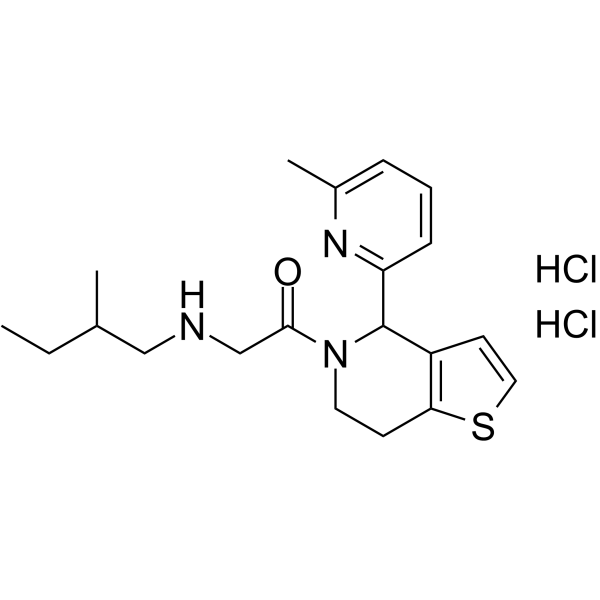RUSKI-201 dihydrochloride
Modify Date: 2024-01-12 20:31:43

RUSKI-201 dihydrochloride structure
|
Common Name | RUSKI-201 dihydrochloride | ||
|---|---|---|---|---|
| CAS Number | 2320262-09-5 | Molecular Weight | 430.43 | |
| Density | N/A | Boiling Point | N/A | |
| Molecular Formula | C20H29Cl2N3OS | Melting Point | N/A | |
| MSDS | N/A | Flash Point | N/A | |
Use of RUSKI-201 dihydrochlorideRUSKI-201 dihydrochloride is a potent and specific Hedgehog acyltransferase (Hhat) inhibitor with an IC50 of 0.20 μM. RUSKI-201 dihydrochloride is able to block Hh signaling from Shh overexpressing cells and inhibits Hh palmitoylation. RUSKI-201 dihydrochloride is potential Hhat chemical probe in cells and can used in studies of Hhat catalytic function[1]. |
| Name | RUSKI-201 dihydrochloride |
|---|
| Description | RUSKI-201 dihydrochloride is a potent and specific Hedgehog acyltransferase (Hhat) inhibitor with an IC50 of 0.20 μM. RUSKI-201 dihydrochloride is able to block Hh signaling from Shh overexpressing cells and inhibits Hh palmitoylation. RUSKI-201 dihydrochloride is potential Hhat chemical probe in cells and can used in studies of Hhat catalytic function[1]. |
|---|---|
| Related Catalog | |
| In Vitro | RUSKI-201 (0.5-25 μM; 48 hours) has no effect on cell viability at concentrations >25 μM in Shh-Light2 cells derived from NIH3T3 cells stably transfected with a Gli-responsive firefly luciferase HEK-293 cells stably overexpressing Shh[1]. RUSKI-201 inhibits signaling in H520, Panc-1, and MCF-7 coculture with Shh-Light2 cells (IC50=4.8±0.60 μM, 7.8±1.3 μM, and 8.5±0.65 μM, respectively)[1]RUSKI-201 (0.01-10 μM; 24 hours) induces a selective inhibition of Shh palmitoylation and does not affect global palmitoylation levels in HEK-293 Shh+ cells treated with RUSKI-201 followed by YnPal and functionalized with AzTB[1]. Western Blot Analysis[1] Cell Line: HEK-293 Shh+ cells Concentration: 0.01 μM, 0.05 μM, 0.1 μM, 0.5 μM, 1 μM, 5 μM, 10 μM Incubation Time: 24 hours Result: Decreased YnPal-Shh expression without α-Shh change; Capable of blocking Hh signaling from Shh overexpressing cells. |
| References |
| Molecular Formula | C20H29Cl2N3OS |
|---|---|
| Molecular Weight | 430.43 |